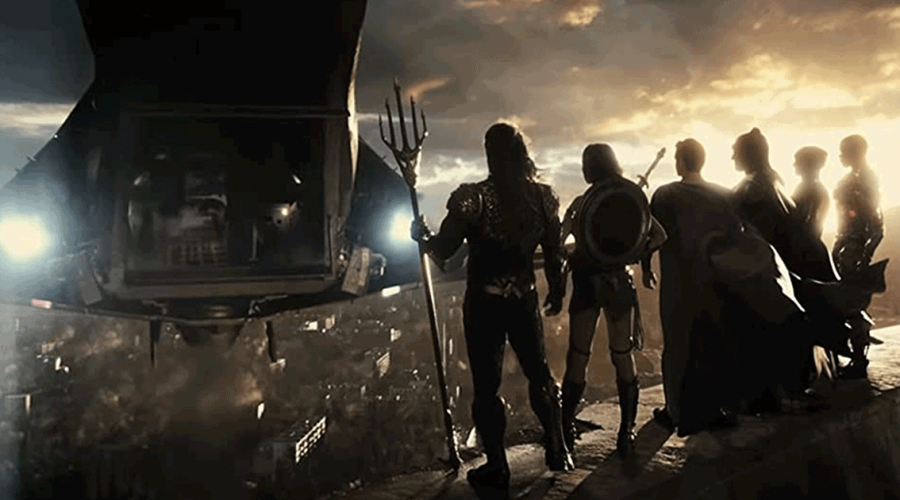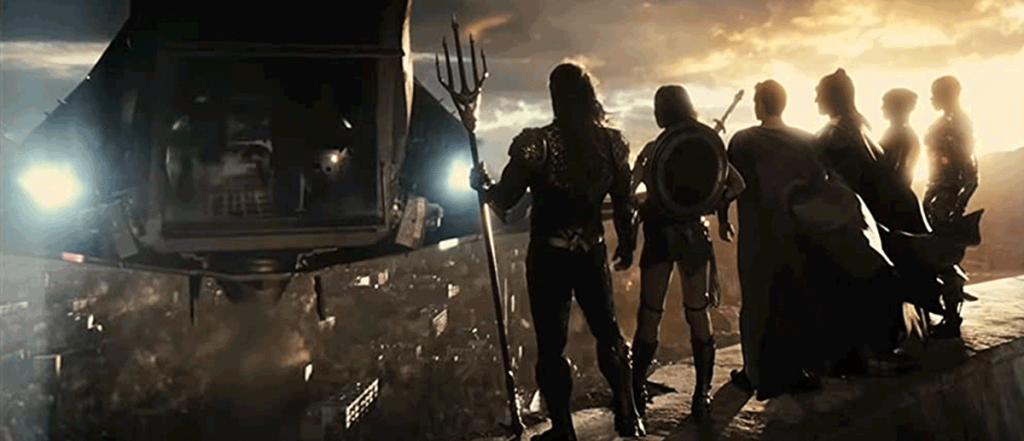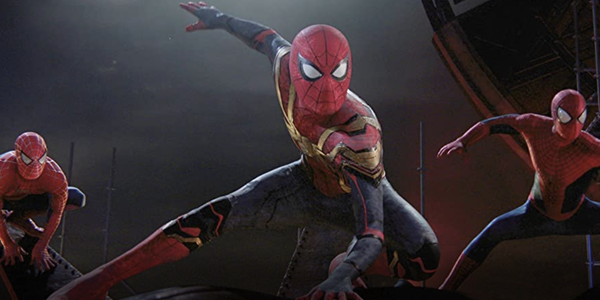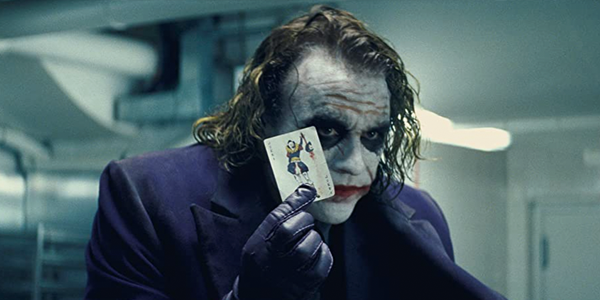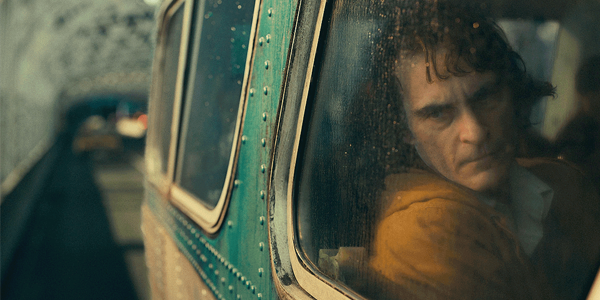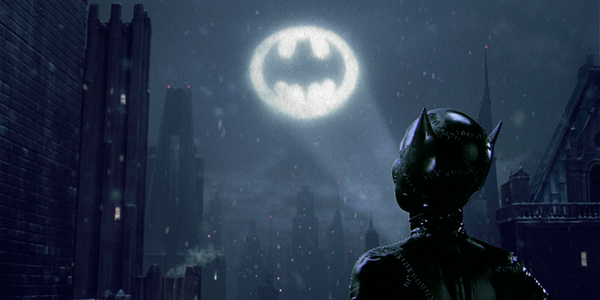Review: Zack Snyder’s Justice League
recent reviews
Sign up for our monthly newsletter
to stay up to date on Cineluxe
Darker in tone, theme, and style than the Whedon version, Snyder’s cut makes for a more satisfying take on the film
by John Sciacca
March 21, 2021
While it’s probably possible to talk about Zack Snyder’s Justice League (aka “The Snyder Cut”) released last week on HBO Max on its own without discussing all of the baggage that comes with it, some context seems appropriate to establish why and how this all came to be.
First, we need to travel back to 2017. Snyder had completed the first of two DC films for Warner Bros., Man of Steel (2013) and Batman v Superman: Dawn of Justice (2016), which were going to establish and launch the DC Extended Universe, setting it up to stand against the tide of Marvel heroes. As Snyder was deep in the process of completing his followup film, Justice League, tragedy struck his family when 20-year-old daughter, Autumn, took her own life. Understandably, Snyder and his wife Deborah (who was working as producer on the film) felt unable to continue with the demands of production and battling with the studio to get the film completed on his terms, and decided to step away to focus on their family.
Warner, with millions already invested and most of Snyder’s filming complete, brought in Joss Whedon to direct and bring the film across the finish line. Many had complained that Snyder’s vision for the DCEU was too dark (Batman v Superman had a critics’ score of just 29%), and that Whedon’s more light-hearted approach combined with his prior success working on two Avengers films (The Avengers and Avengers: Age of Ultron) was the right tone to help get the DCEU back on track.
Whedon took over the reins, rewriting, reshooting, and editing the film, injecting some humor to lighten the dark tone as well as making major trims to meet Warner’s alleged mandate of hitting a two-hour runtime—frankly an overly ambitious goal in a film planning on introducing three major new characters that would help carry the film and drive the DCEU forward, resurrecting another, setting up a new franchise Big Bad, and then having this newly assembled team save the world.
The result was 2017’s Justice League, a film Snyder says his wife and executive producer Christopher Nolan told him never to see as it “would break his heart,” and one that seemed to disappoint more people than it pleased. (Though it must be pointed out that both its critics’ and audience ratings were higher than Snyder’s BvS.)
Over the years, rumors started circulating that Snyder had all of the footage he shot during his time in the director’s seat and he had assembled a rough cut he’d shown to some friends and insiders, and that this true vision of Justice League was a film that righted all wrongs.
Fans glommed onto this and started a #ReleaseTheSnyderCut movement filled with the usual social-media fervor, including toxic and hateful rhetoric and cyberbullying on Twitter and Reddit and at least one death threat. Even members of the Justice League cast and crew started showing support for the release of Snyder’s version, and the movement continued to grow.
A lot of hate was spewed at Whedon, who—at least as far as I can tell—handled it all like a silent professional. Also, it’s important to remember that he never asked for any of this. He wasn’t clamoring to take the film away from Snyder—he was brought in at the 11th hour to save a major project. This is kind of like a pinch hitter being brought in to replace an injured player who is then told by the manager he has to bunt, and then being crucified for not living up to the crowd’s expectations.
At any other time, this likely would have never gone anywhere, but then Warner launched HBO Max. Hungry to gobble up subscribers with unique and desirable content—and with a huge legion of rabid fans out there clamoring for it—Warner gave Snyder the go-ahead—and budget—to finish his version, announcing that it would stream exclusively on the new platform.
Whether you want to compare this to negotiating with terrorists or not, it actually makes a lot of sense from Warner’s perspective. This groundswell of fan support created a ton of social-media buzz and free advertising the studio literally couldn’t have purchased. At a time when much of Hollywood was shut down, it also fast-tracked a marquee title exclusively available on its streaming service, with less than a year passing between the announcement and the film’s availability. While the estimated $70 million required to finish the special effects and do some reshoots might sound like a lot—especially on top of the estimated $300 million Warner had already sunk into the film—it certainly isn’t unheard of for a tentpole title. (You might recall Disney paid $75 million for the worldwide rights to Hamilton, and Apple paid $70 million for Tom Hanks’ film Greyhound.) It also brings a ton of interest back to the DC universe, with multiple new films in the pipeline, and likely considering any additional monies spent on the Snyder Cut as investments in future properties. So . . . that kind of sets the stage for Zack Snyder’s Justice League.
After all the protests and demands and waiting, is this 4-hour-and-2-minute film a better experience that’s worth your time? Yes. I can’t think that too many people would prefer Whedon’s JL to Snyder’s, as the ZSJL is just a far more complete and finished experience. (And currently stands with a critics’ score of 74% and Audience Score of 96% on Rotten Tomatoes.)
But, it’s also a totally unfair comparison. The ZSJL cut we have here would never have seen an actual release. It isn’t enough of a film to be split into two-parts à la the final Avengers films, and even if it had been allowed to be released at an extended 3 hour run time, that would have required an hour of trimming from what we have here.
Honestly, much of the film and overall experience feels overly indulgent. This isn’t to say it isn’t mostly entertaining, it just feels like . . . a journey. And sometimes a long one at that. Here, Snyder is free to do whatever he wants without the limits of time nor benefit of any outside input of test screenings to see ways to improve (reminding me a bit of George Lucas surrounding himself with “Yes!” men when working on the Star Wars prequel trilogies).
Beyond the runtime, we have Snyder’s decision to release the film in a 4:3 aspect ratio, with a title card reading, “This film is presented in a 4:3 format to preserve the integrity of Zack Snyder’s creative vision” appearing just before it begins. Sure, this might play great—and larger—on a giant commercial IMAX screen. which is Snyder’s ultimate goal, but for the 99.9% of HBO Max viewers who will be watching this on a 16:9 screen (let alone a 2.35:1 screen without the benefit of masking!) this “huge” movie feels smaller.
At least Snyder pulled back from one of his original goals, to release the film in black & white. (He says “the ultimate version is the black-and-white IMAX version of the movie.”) Also, it feels like he was reaching for an edgier R rating for some reason, throwing in three completely arbitrary and out-of-place-feeling F-words to force the MPAA’s hand. Sigh . . .
At times, the movie feels like a kitchen-sink approach, lacking editorial restraint. Scenes like the singing after we see Aquaman entering the water or the ballad played over the lengthy slow-motion of The Flash saving future girlfriend Iris West just feel drawn out.
Even though Snyder has said he wouldn’t use a single frame of footage he hadn’t shot, fundamentally the ZSJL is much the same film as Whedon’s 2017 movie, and watching it doesn’t feel like a wholly new experience so much as a fuller experience—kind of like skimming the Cliffs Notes of War and Peace versus sitting down and pondering every word. The film still has Wonder Woman (Gal Gadot) and Batman (Ben Affleck) looking to locate and unite the same band of heroes: Aquaman (Jason Momoa), The Flash (Ezra Miller), and Cyborg (Ray Fisher). Once joined, the newly formed League fights alien-baddy Steppenwolf (a CGI character voiced by Ciaran Hinds), trying to keep him from collecting three otherworldly Mother Boxes he plans to join into a planet-killing unity. After claiming the Boxes from the Amazons and Atlanteans, the League uses the box entrusted to humans centuries before to bring Superman (Henry Cavill) back to help in their fight—a showdown against Steppenwolf and his horde of Parademons in an abandoned nuclear reactor in Russia.
Much of the order of the film is the same and all the big fights and encounters remain. The tone is just darker and heavier throughout, with virtually all of the levity and quips gone. You get a sense of the difference in tone and narrative structure from the very opening. Where JL 2017 opened with (a heavily CGI de-mustached) Superman talking about hope and pondering his favorite thing about Earth after doing some Superman rescue, ZSJL opens with Superman being killed (from the end of BvS), his death screams echoing around the globe and causing the Mother Boxes to awaken, thus announcing their presence to Steppenwolf.
Everything is just way more developed, with characters getting far more fleshed-out backstories, particularly pre-Cyborg Victor Stone. (One thing that isn’t “developed” is Whedon’s random Russian family stuck in a house near the power plant. That foolish little subplot has been excised.) We also get a much deeper look into Aquaman’s Atlantis. Relationships make more sense because they have two more hours to be explored and expanded, and the team coming together feels more authentic because it isn’t just thrown together over a matter of minutes.
Battles are also longer, more intense, and more violent, with action shown from different angles and perspectives. In Whedon’s JL, Steppenwolf seems virtually unstoppable as he just rolls through the heroes claiming the boxes, only to ultimately be saved as Superman appears at the 11th hour to save the day. In the ZSJL we get a sense the band of heroes could defeat Steppenwolf even without Supe, and his conquests are much harder fought along the way. Another big change—though not fundamentally affecting the film, although it would have guided the DCEU going forward had Snyder’s vision prevailed—is that Steppenwolf (who also has a completely different look here) is not the Big Bad but rather just a servant of ultimate baddy, Darkseid (another CGI character, voiced by Ray Porter), who would have been akin to Marvel’s Thanos.
We have to assume that with all the trouble—and expense—Warner has gone to to give Snyder this mulligan, everything we see is exactly the way he wanted, which makes it interesting that Snyder chose to divide the experience into chapters, with six parts followed by an epilogue:
Part 1: Don’t Count on it, Batman
Part 2: The Age of Heroes
Part 3: Beloved Mother, Beloved Son
Part 4: Change Machine
Part 5: All the King’s Men
Part 6: Something Darker
Epilogue: A Father Twice Over
While it makes for convenient stopping points when watching (the end of Part 3 is almost a perfect halfway point) and seems ready-made for episodic streaming, these part breaks within the film don’t seem to serve any other purpose other than introducing what’s coming, and actually take you out of the moment a bit.
Visually, you get used to the 4:3 aspect ratio fairly quickly (especially if you have some screen masking), with the more vertical presentation making our standing heroes appear taller. In practical terms, this took my 115-inch 2.35:1 screen (92-inch 16:9) down to a 75-inch 4:3 experience, which certainly was a bit less cinematic. The HBO Max plus presentation is in 4K HDR, including Dolby Vision and Dolby Atmos.
Shot on 35mm film and taken from a 4K digital intermedia, image quality is clean, though I never felt it was bristling with sharpness and detail. In fact, in between Parts 3 and 4, we watched the first episode of Falcon and Winter Soldier on Disney+, and that looked sharper and more detailed. I was never taken by the micro detail in fabric or razor sharpness in a scene—in fact, some shots were noticeably softer than others. It certainly didn’t have the visual pop of other IMAX films, such as Mission: Impossible—Fallout. Whether this a case of the limitation of HBO Max’s streaming bandwidth or the source material is difficult to say.
As mentioned, this is a dark film in tone, theme, and visual style. Much of it takes place either at night or in some darkened interior. Even the daylight scenes—such as between Clark and Lois Lane (Amy Adams)—outside in a cornfield are shot at near dusk. Blacks are nice, clean, and deep, and we get a lot of visual pop courtesy of HDR. Things like lights streaming in through windows, computer screens, and headlights all have a realistic look. We also get some nice punchy colors in the form of things like Cyborg’s glowing red eye, Amazonian’s golden outfit, and roaring flames. While I wouldn’t call the streaming experience reference-quality video, it certainly goes beyond merely watchable, and makes me look forward to a second viewing in full-resolution video quality from Kaleidescape.
The film has a pretty aggressive Dolby Atmos mix, with lots of atmospherics that appropriately fill the room. Whether it’s sirens, alarms, machinery, echoes, birds, wind, or motor sounds, interior spaces are rich with different audio cues to place you in the space. The battles also make good use of all speakers, throwing action into all corners of the room.
Even viewing at reference volume level, the mix was missing some of the low-end dynamics I would have expected. Again, I can’t say this is due to the mix itself (unlikely), the limitation of streaming via HBO Max (definitely a factor), or the audio output of my Apple 4KTV (also suspect). While bass wasn’t non-existent, it never had the wallop you’d expect from a big-budget superhero film, and it wasn’t until the climax with the Mother Boxes where I felt like bass was reaching a tactile level I could feel in my seat. Again, it makes me look forward to a second viewing on Kaleidescape in a lossless, Dolby TrueHD Atmos audio mix.
Now that it’s finally here, you have to ask whether the film was worthy of the social movement that helped bring it about and make it a reality. I’d say, no. However, I’d also certainly concede it’s the better Justice League film, offering a far richer viewing experience that is definitely more in line in with the style and tone of Snyder’s two DC films that preceded it and giving us a glimpse into where he thought the DCEU would head. And if completing it and bringing it to the public brought Snyder and his family any personal closure from their tragedy, then that’s another positive. Among movie fans—especially the superhero-loving kind—Zack Snyder’s Justice League is going to be a watercooler topic for some time, and it will be interesting to see what—if any—lasting impact it will have on Warner’s plans for the DCEU.
Probably the most experienced writer on custom installation in the industry, John Sciacca is co-owner of Custom Theater & Audio in Murrells Inlet, South Carolina, & is known for his writing for such publications as Residential Systems and Sound & Vision. Follow him on Twitter at @SciaccaTweets and at johnsciacca.com.
PICTURE | Image quality is clean, though lacking in sharpness and detail
SOUND | The Dolby Atmos mix is pretty aggressive, with lots of atmospherics that appropriately fill the room
© 2023 Cineluxe LLC
